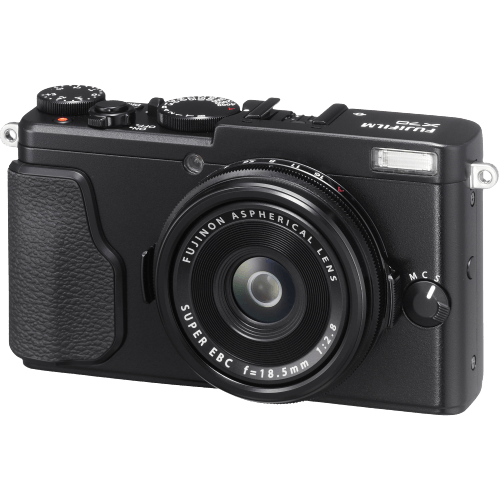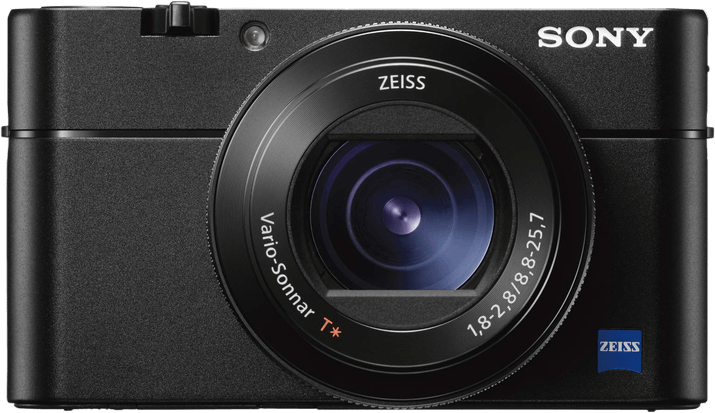Fujifilm X70 vs Sony Cyber-shot DSC-RX100 VA Comparison
Fujifilm X70

Sony Cyber-shot DSC-RX100 VA

The Sony Cyber-shot DSC-RX100 VA outperforms the Fujifilm X70 with a score of 59/100 compared to 53/100. Both cameras share some common specifications, including being released in the 2016-2018 period and having compact designs. The X70 is slightly larger and heavier, measuring 113 x 64 x 44mm and weighing 340g, while the RX100 VA is 102 x 58 x 41mm and weighs 299g.
The RX100 VA is the superior camera due to its higher score, and it’s also more recent, which means it has updated technology. However, the X70 is more affordable with a launch price of $799, compared to the RX100 VA’s $999 price tag.
Considering these factors, the Sony Cyber-shot DSC-RX100 VA is the better option for those seeking advanced technology and better performance, while the Fujifilm X70 is more suitable for those who prefer a budget-friendly option without compromising too much on quality.
Fujifilm X70 vs Sony Cyber-shot DSC-RX100 VA Overview and Optics
The Sony Cyber-shot DSC-RX100 VA takes the lead in optics with a score of 64/100, while the Fujifilm X70 follows closely with a score of 54/100. Both cameras have a CMOS sensor, a fixed lens mount, and neither allows for lens changes.
The RX100 VA surpasses the X70 in several aspects. It has a higher megapixel count of 20, compared to the X70’s 16 megapixels, resulting in sharper and more detailed images. The RX100 VA’s shooting speed is significantly faster at 24 frames per second, while the X70 shoots at 8 frames per second. This makes the RX100 VA more suitable for action photography. Additionally, the RX100 VA’s sensor has a DXOMARK score of 70, which is a reliable indicator of its excellent image quality. Moreover, the RX100 VA has image stabilization, which minimizes camera shake and results in clearer photos, especially in low light situations.
On the other hand, the Fujifilm X70 has a larger sensor size (APS-C), which can potentially produce better image quality and low-light performance compared to the RX100 VA’s 1-inch sensor. However, DXOMARK does not score Fujifilm cameras, so it’s not possible to directly compare their sensor performance.
In terms of optics, the Sony Cyber-shot DSC-RX100 VA is the superior choice due to its higher megapixel count, faster shooting speed, and image stabilization. The Fujifilm X70 may offer better image quality with its larger sensor size, but without a DXOMARK score, it’s difficult to make a definitive comparison.
Fujifilm X70 vs Sony Cyber-shot DSC-RX100 VA Video Performance
The Sony Cyber-shot DSC-RX100 VA outperforms the Fujifilm X70 in video capabilities with a score of 77/100 compared to the X70’s score of 70/100. Both cameras share some features, such as having Full HD video resolution and built-in time-lapse functionality. However, the RX100 VA has additional advantages that make it the better choice for video recording.
One of the most significant advantages of the RX100 VA is its 4K video resolution, which is higher than the X70’s maximum video resolution of Full HD. This allows the RX100 VA to capture more detail in videos, resulting in better overall video quality. Additionally, the RX100 VA boasts a maximum video frame rate of 120fps, double the X70’s maximum frame rate of 60fps. This higher frame rate enables the RX100 VA to produce smoother video playback and better slow-motion effects.
On the other hand, the Fujifilm X70 does have the advantage of built-in time-lapse functionality, which is not available in the RX100 VA. This feature can be useful for creating dynamic videos of scenes that change over time, such as sunsets or moving clouds.
Taking these factors into account, it is clear that the Sony Cyber-shot DSC-RX100 VA is the superior choice for video capabilities due to its higher video resolution and frame rate. The Fujifilm X70, while offering useful time-lapse functionality, falls short in comparison. Therefore, for those seeking a camera with strong video performance, the RX100 VA is the better option.
Fujifilm X70 vs Sony Cyber-shot DSC-RX100 VA Features and Benefits
The Fujifilm X70 and the Sony Cyber-shot DSC-RX100 VA both score 57/100 in features, making them equal in this aspect. They share several specifications, including a 3-inch screen size, touchscreen capabilities, flip screens, no GPS, WiFi connectivity, and no Bluetooth.
The Sony Cyber-shot DSC-RX100 VA has a higher screen resolution at 1,228,800 dots compared to the Fujifilm X70’s 1,040,000 dots. This higher resolution provides a clearer and more detailed display for users when composing and reviewing images.
On the other hand, the Fujifilm X70 does not have any significant advantages over the Sony Cyber-shot DSC-RX100 VA in terms of features. Both cameras have the same score and share most of the specifications.
After comparing the features of both cameras, it is clear that they are evenly matched. The Sony Cyber-shot DSC-RX100 VA has a slight edge with its higher screen resolution, but this may not be a deciding factor for some users. Ultimately, the choice between these two cameras will depend on personal preferences and other factors such as optics, video capabilities, and price.
Fujifilm X70 vs Sony Cyber-shot DSC-RX100 VA Storage and Battery
The Fujifilm X70 outperforms the Sony Cyber-shot DSC-RX100 VA in storage and battery with a score of 21/100, while the Sony camera scores 13/100. Both cameras have one memory card slot and accept SD, SDHC, and SDXC memory cards.
The Fujifilm X70 has a longer battery life, providing 330 shots, compared to the Sony DSC-RX100 VA’s 220 shots. The X70 uses an NP-95 battery, while the Sony camera utilizes an NP-BX1 battery. Neither camera supports USB charging.
The Sony DSC-RX100 VA has an advantage in memory card compatibility, as it also accepts Memory Stick Duo, Pro Duo, and Pro-HG Duo cards.
Considering the storage and battery aspects, the Fujifilm X70 offers superior battery life, making it more suitable for extended use. However, the Sony DSC-RX100 VA provides greater flexibility in memory card options.
Fujifilm X70 vs Sony Cyber-shot DSC-RX100 VA – Our Verdict
Are you still undecided about which camera is right for you? Have a look at these popular comparisons that feature the Fujifilm X70 or the Sony Cyber-shot DSC-RX100 VA:
- Canon EOS R50 vs Sony Cyber-shot DSC-RX100 VA
- Fujifilm X70 vs Nikon D7200
- Sony Cyber-shot DSC-RX100 VA vs Cyber-shot DSC-RX100 VII
- Panasonic Lumix ZS200 (TZ200) vs Sony Cyber-shot DSC-RX100 VA
- Sony Cyber-shot DSC-RX100 VA vs Cyber-shot RX10 IV
- Canon PowerShot G7 X Mark III vs Sony Cyber-shot DSC-RX100 VA
